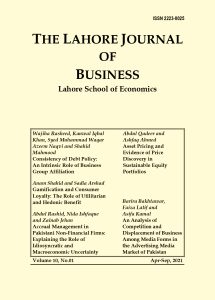Driving Customer Loyalty through Customer Satisfaction in Online Shopping: The Role of Brand Image, Price, Trust and Website Quality
- Rimsha Shafiq
- rimsha.shafiq111@gmail.com
- MS Student, Faculty of Management Sciences, University of Central Punjab (Corresponding Author)
Submitted
November 22, 2023
Accepted
November 22, 2023
Accepted
November 22, 2023
Abstract
The relationship between brand image and loyalty in online shopping has gained significant attention in the marketing literature. Despite this attention, the specific path linking brand image to customer loyalty remains unclear. This study delves into the sequential and parallel mediations between brand image and customer loyalty, aiming to identify the effects of brand image, price, trust and website quality on customer loyalty through the mediation of customer satisfaction. Employing a parallel and sequential mediation model, this research addresses the practical implications for emerging e-commerce businesses. For data collection, an online questionnaire survey
distributed to 120 respondents yielded a 65 percent response rate. The findings of the study affirm that brand image, price and trust positively influence customer satisfaction and loyalty, establishing direct and indirect relationships among these constructs. This study contributes to the validation of the proposed research model in the specific context of a developing country, i.e., Pakistan.
Keywords
Abusive
supervision
interpersonal
deviance
organizational deviance
psychological safety
organizational identification.
This work is licensed under LJB.
- Citation
:Shafiq, R., Naveed, S., & Zeeshan, M. (2023). Driving Customer Loyalty through
Customer Satisfaction in Online Shopping: The Role of Brand Image, Price, Trust and Website
Quality. The Lahore Journal of Business, 11(1), 103-122
- References
2: Agarwal, B., & Gulla A. (2022). Influence of social media marketing on customer equity drivers and purchase intention: Understanding world’s most valuable brand—Amazon. Management Review, 30(3), 99–113.
3: Agarwal, R., & Karahanna, E. (2000). Time flies when you’re having fun: Cognitive absorption and beliefs about information technology usage. MIS Quarterly, 24(4), 665–694.
4: Alsaad, A., Mohamad, R., & Ismail, N. A. (2017). The moderating role of trust in business-to-business electronic commerce (B2B EC) adoption. Computers in Human Behavior, 68, 157–169.
5: Altaf, M., Iqbal, N., Mokhtar, S. S., & Sial, M. H. (2017). Managing consumer-based brand equity through brand experience in Islamic banking. Journal of Islamic Marketing, 8(2), 218–242
6: Ananda, A., Hernandez-Garcia, A., Acquila-Natale, E., & Lamberti, L. (2019). What makes fashion consumers ‘click’? Generation of eWoM engagement in social media. Asia Pacific Journal of Marketing and Logistics, 31(2), 398–418.
7: Animesh, A., Pinsonneault, A., Yang, S. B., & Oh, W. (2011). An odyssey into virtual worlds: Exploring the impacts of technological and spatial environments on intention to purchase virtual products. MIS Quarterly, 35(3), 789–810.
8: Appiah, D., Ozuem, W., Howell, K. E., & Lancaster, G. (2019). Brand switching and consumer identification with brands in the smartphones industry. Journal of Consumer Behavior, 18(6), 463–473.
9: Ausat, A. M. A. (2023). The role of social media in shaping public opinion and its influence on economic decisions. Technology and Society Perspectives, 1(1), 35–44.
10: Baldus, B. J., Voorhees, C., & Calantone, R. (2015). Online brand community engagement: Scale development and validation. Journal of Business Research, 68(5), 978–985.
11: Bazi, S., Filieri, R., & Gorton, M. (2023). Social media content aesthetic quality and customer engagement: The mediating role of entertainment and impacts on brand love and loyalty. Journal of Business Research, 160, 113778.
12: Beck, S., & Prügl, R. (2018). Family firm reputation and humanization: Consumers and the trust advantage of family firms under different conditions of brand familiarity. Family Business Review, 31(4), 460–482.
13: Beig, F. A., & Khan, M. F. (2018). Impact of social media marketing on brand experience: A study of select apparel brands on Facebook. Vision, 22(3), 264-275.
14: Bell, E., Bryman, A., & Harley, B. (2018). Business research methods. Oxford University Press.
15: Brakus, J. J. J., Schmitt, B. H., & Zarantonello, L. (2009). Brand experience: What is it? How is it measured? Does it affect loyalty? Journal of Marketing, 73(3), 52–68.
16: Bruhn, M., Schoenmueller, V., & Schäfer, D. B. (2012). Are social media replacing traditional media in terms of brand equity creation? Management Research Review, 35(9), 770–790.
17: Cassel, C., Hackl, P., & Westlund, A. H. (1999). Robustness of partial least-squares method for estimating latent variable quality structures. Journal of Applied Statistics, 26(4), 435–446.
18: Chen, S. C., & Lin, C. P. (2019). Understanding the effect of social media marketing activities: The mediation of social identification, perceived value and satisfaction. Technological Forecasting and Social Change, 140, 22–32.
19: Chen, X., & Qasim, H. (2020). Does e‐brand experience matter in the consumer market? Explaining the impact of social media marketing activities on consumer‐based brand equity and love. Journal of Consumer Behavior, 20(5), 1065–1077.
20: Chin, W. W., Thatcher, J. B., Wright, R. T., & Steel, D. (2013). Controlling for common method variance in PLS analysis: the measured latent marker variable approach. In Chin, W.W., Russolillo, V.E.
Read More
